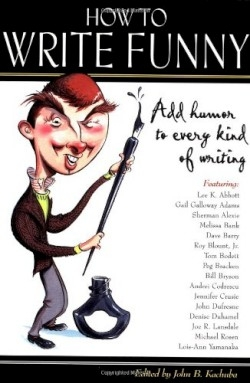How to Write Funny
“What one person finds funny another person finds deranged,” states Robin Hemley, whose essay,
“Relaxing the Rules of Reason,” opens this collection of works by humor writers, designed to help authors incorporate wit into all kinds of writing, from science fiction to romance to children’s books. The editor, who is also a writer and journalist, has previously edited R.T. Stone’s The Journals and has written Why Is This Job Killing Me? His fiction has been published in literary journals, and his nonfiction has appeared in Poets and Writers and other publications.
One theme that runs through the essays is Hemley’s idea that each person has a unique sense of humor. Our experiences in life determine what we find amusing. For instance, Native American writer Sherman Alexie discusses how he was influenced not only by the storytelling tradition of his people, but also by reruns of the Brady Bunch. Bill Bryson cites the impact of living in England for twenty years, and explains the differences between American and British humor (snappy one-liners vs. off-the-wall surrealism).
David Bouchier examines the danger of using too many jokes. He points out that it is far more effective to have a genuinely funny character who naturally does and says laughable things than to pepper jokes throughout a story. David Evans agrees, offering a test for whether a piece works or not: if the jokes can be removed and it’s still funny, then it’s a good story. “Jokes are the horseradish sauce of comedy,” he explains, “not the roast beef.”
The editor provides exercises to help writers learn to write with wit, like describing oneself using only metaphor and simile, and thinking in “outlandish terms,” such as “he looked like a toolbox.” Another exercise suggests cutting a photo out of a newspaper or magazine and then writing three different explanations for what is happening in it.
Humor has been considered non-literary, but Jennifer Crusie Smith points out that it is currently rising in popularity, especially women’s humor. For instance, Harlequin has launched a “Love and Laughter” line in response to readers’ demands. Lee K. Abbott posits that since everyone laughs at something every day, this laughter is an integral part of the human character, so seriousness is not the only true art.
Asked about the fact that his writing was in the humor section of the bookstore instead of the literary section, P.J. O’Rourke replied: “Cats vs. Keats. Who wins at the cash register? Garfield every time.”
Disclosure: This article is not an endorsement, but a review. The publisher of this book provided free copies of the book to have their book reviewed by a professional reviewer. No fee was paid by the publisher for this review. Foreword Reviews only recommends books that we love. Foreword Magazine, Inc. is disclosing this in accordance with the Federal Trade Commission’s 16 CFR, Part 255.

